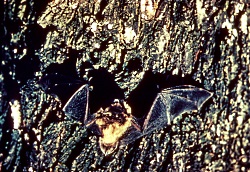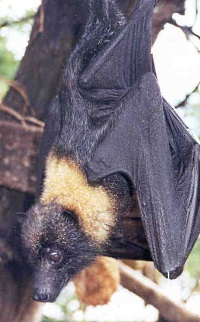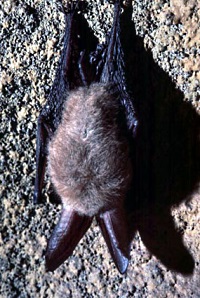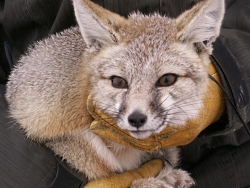
with an adult kit fox
that was captured
with a box trap.
Kit foxes are weighed,
fitted with a radio collar,
and then released
Courtesy & Copyright © 2010
Bryan Kluever
Graduate Research Assistant
Utah State University
Dept of Wildland Resources
Hi, I’m Holly Strand from Stokes Nature Center in beautiful Logan Canyon.
The kit fox just might be Utah’s cutest mammal. Weighing in at four to five pounds or so, the kit fox is about a third of the size of the more common red fox.. The kit fox has delicate cat- like features and it has comically large, furry ears. It’s desert-colored coat is tinged with rusty orange finishing in a long black-tipped bushy tail.
The kit fox is the only desert dwelling fox in North America. In Utah, you’ll find it mostly in the western part of the state, where it lives off field mice and jackrabbits as well as insects, birds, amphibians and fish.
The kit fox has evolved a number of adaptations to deal with the desert’s harsh conditions.. First of all those big ears aren’t just for looks. They help the kit fox dissipate body heat through evaporative cooling.
Secondly, kit foxes are nocturnal, avoiding the high temperatures of the daytime hours. During the day they lounge in subterranean dens.
Kit fox legs are relatively short for a fox. That helps them zig-zag through the brush when chasing prey or being chased. And the pads of their paws are furry which gives them better traction in the sandy soil of desert habitats.
Long droughts are common in desert environments and kit foxes have developed ways to deal with them. During a drought, fewer vixens breed and litters become smaller. Kit fox families maintain large territories—larger than necessary for normal years. So when a drought hits, and the population of prey species plummets, the foxes have a larger area in which to hunt.
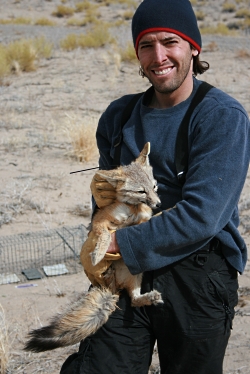
released. Note the black
collar antenna on the right
side of the fox.
Courtesy & Copyright © 2010
Bryan Kluever
Kit foxes get top marks in water conservation. Little goes in and little comes out.. A kit fox can exist for many months without ever drinking water. Instead, the fox can draw water from the food that it eats. And that water is used with great efficiency. Little is lost through metabolic processes such as urination, defecation breathing and panting.
Too see pictures of the diminitive kit fox, go to www.wildaboututah.org
Thanks to Brian Kleuwer and Mary-Ann Muffoletto of Utah State University’s College of Natural Resources for supporting this Wild about Utah topic.
For Wild About Utah and Stokes Nature Center, I’m Holly Strand.
Credits:
Images: Courtesy & Copyright Bryan Kluever, USU Department of Wildland Resources
Text: Mary-Ann Muffoletto, Utah State University College of Natural Resources
Additional Reading:
White, P. J. and K. Ralls. 1993. Reproduction and spacing patterns of kit foxes relative to changing prey availability. Journal of Wildlife Management 57:861–867 The Wildlife Society, https://si-pddr.si.edu/dspace/bitstream/10088/510/1/White1993.pdf
Kit Fox (Vulpes macrotis), Wildlife Notebook Series No. 9, Utah Division of Wildlife Resourceswildlife.utah.gov/publications/pdf/2010_kit_fox.pdf
Kit Fox (Vulpes macrotis), Species Fact Sheets, Utah Conservation Data Center, Utah Division of Wildlife Resources, https://dwrcdc.nr.utah.gov/rsgis2/Search/Display.asp?FlNm=vulpvelo


